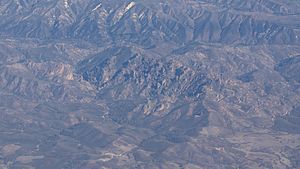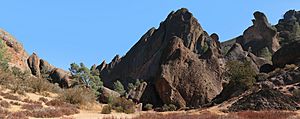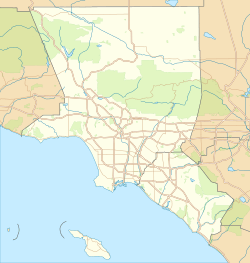Neenach Volcano facts for kids

The Neenach Volcano was an ancient volcano in California that is now extinct, meaning it won't erupt again. It formed about 23 million years ago in the mountains of California. What makes this volcano super interesting is that it was split in half by the mighty San Andreas Fault. Over millions of years, these two halves have moved far apart – about 195 miles (314 kilometers)!
Scientists call the two parts the Pinnacles and Neenach volcanic formations. Finding these two halves and realizing they were once one volcano is a "classic example" of how plate tectonics works. This is the scientific idea that Earth's outer layer is made of huge, moving plates. Researchers found ten types of rocks that are almost exactly the same in both formations. They also found them in the same order, like layers in a cake. This strong evidence proves that the two parts really did come from the same volcano and have moved apart because of the San Andreas Fault.
How the Volcano Formed and Split
The Neenach Volcano was born 23 million years ago. This happened when one of Earth's big ocean plates, called the Juan de Fuca Plate, slid underneath the North American Plate. This process, called subduction, often causes volcanoes to form near where the plates meet.
Later, about 20 million years ago, some complicated natural processes caused a part of the Juan de Fuca Plate to stick to the edge of the Pacific Plate. This stopped the sliding-under process (subduction). Instead, the Pacific Plate and the North American Plate started sliding past each other. This sideways movement created the famous San Andreas Fault.
The Neenach Volcano was right on top of this new fault line. As the plates began to slide, the fault literally ripped the volcano in two! The plates move very slowly, about 1.5 centimeters (half an inch) each year. That's like six inches every ten years. But over millions of years, this slow movement caused the two halves of the volcano to drift 195 miles apart. Over time, wind and water also wore down the volcano, leaving behind the smaller rock formations we see today.
The Western Half: Pinnacles National Park
You can find the western part of the old volcano in Pinnacles National Park. 36°29′55.44″N 121°12′9.02″W / 36.4987333°N 121.2025056°W The most famous rock formations in the park, like High Peaks and Balconies, are mostly made from volcanic ash and rock that exploded out of the volcano. These include rocks like volcanic breccia (broken rock pieces cemented together), rhyolite lava flows, and volcanic tuff (hardened ash). You can also find some andesite lava flows in a few spots.
Pinnacles National Park covers about 42 square miles. The rocks from the Neenach Volcano make up about 20 square miles of the park's total area.
The Eastern Half: Neenach Formation
The eastern part of the volcano, called the Neenach Formation, is about 195 miles (314 kilometers) south of Pinnacles National Park. It's located near a town called Neenach, California. 34°44′58.30″N 118°35′51.62″W / 34.7495278°N 118.5976722°W This formation covers about 10 square miles. It's special because of a very straight line on its southern side. This line is where the San Andreas Fault sliced the original volcano in two. You can see this southern edge from Pine Canyon Road.
The rocks here are mostly dacite and andesite flows. They have worn down into low, rolling hills, unlike the dramatic rock towers you see at Pinnacles. Satellite images show some areas of rhyolitic tuff and lapilli tuff. This is a light green volcanic rock that is also found in Pinnacles National Park. It was even used to build the visitor center there!
Most of the Neenach Formation is on private land. However, a part of the Pacific Crest Trail, a famous hiking trail, goes through the Neenach area. You can access it from trailheads along Lancaster Road and Pine Canyon Road.



